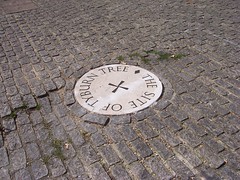
Traduzione by DANILA FORESTI, volontaria di English Gratis. Il testo originale è tratto da una pagina del sito inglese di Wikipedia ed è disponibile nel rispetto della licenza Creative Commons Attribution 2.5 ![]() photo credit: Loz Flowers
photo credit: Loz Flowers

Tyburn (2)
Tyburn (2)
Tyburn gallows
La forca di Tyburn
Executions took place at Tyburn until the 18th century (with the prisoners processed from Newgate Prison in the City, via St Giles in the Fields and Oxford Street), after which they were carried out at Newgate itself and at Horsemonger Lane Gaol in Southwark.
Le esecuzioni ebbero luogo a Tyburn fino al 18° secolo (i prigionieri venivano trasferiti dalla Prigione di Newgate nella City, passando per St. Giles in the Fields e Oxford Street); in seguito le esecuzioni venivano compiute nella stessa prigione di Newgate stessa e presso il Carcere di Horsemonger Lane nel quartiere di Southwark.
The first recorded execution took place at a site next to the stream in 1196.
La prima esecuzione, di cui si abbia notizia certa, venne eseguita in un luogo vicino al torrente Tyburn nel 1196.
William Fitz Osbern, the populist leader of the poor of London was cornered in the church of St Mary le Bow.
William Fitz Osbern, il leader populista dei poveri di Londra, fu catturato nella chiesa di St. Mary le Bow.
He was dragged naked behind a horse to Tyburn, where he was hanged.
Egli fu trascinato, nudo, da un cavallo fino a Tyburn, dove fu impiccato.
In 1537, Henry VIII used Tyburn to execute the ringleaders of the Pilgrimage of Grace, including Nicholas Tempest, one of the northern leaders of the Pilgrimage and the King’s own Bowbearer of the Forest of Bowland.
Nel 1537, Enrico VIII si servì di Tyburn per giustiziare gli esponenti di punta (ribelli) del “Pilgrimage of Grace (Pellegrinaggio di Grazia ovvero rivolta avvenuta a York, e nell’Inghilterra settentrionale, nel 1536 contro Enrico VIII a causa della rottura con la Chiesa Cattolica Romana), tra i quali Nicholas Tempest, uno dei capi dei rivoltosi del nord e “Bowbearer” (letteralmente portatore dell’arco da caccia del re. Sottufficiale che soprintendeva alla sicurezza della foresta) del re medesimo (1519-1526) per la Foresta di Bowland.
In 1571, the “Tyburn Tree” was erected near the modern Marble Arch.
Nel 1571, il “Tyburn Tree” fu eretto nelle vicinanze del moderno Marble Arch.
>>> The “Tree” or “Triple Tree” was a novel form of gallows, comprising a horizontal wooden triangle supported by three legs (an arrangement known as a “three legged mare” or “three legged stool”).
L’Albero, oppure “Triplo Albero” era una nuovo esemplare di patibolo, costituito da un triangolo di legno orizzontale sostenuto da tre pertiche (una disposizione nota come “giumenta a tre zampe” oppure “sgabello a tre gambe”).
Several felons could thus be hanged at once, and so the gallows were used for mass executions, such as on 23 June 1649 when 24 prisoners – 23 men and one woman – were hanged simultaneously, having been conveyed there in eight carts.
Più criminali potevano, quindi, essere impiccati contemporaneamente, perciò la forca veniva impiegata per le esecuzioni di massa, come accadde il 23 giugno 1649, quando 24 prigionieri – 23 uomini ed una donna – furono uccisi simultaneamente, dopo essere stati trasportati colà su otto carri.
The Tree stood in the middle of the roadway, providing a major landmark in west London and presenting a very obvious symbol of the law to travellers.
La forca era collocata nel mezzo della carreggiata, offrendo un inequivocabile punto di riferimento alla zona ovest di Londra ed una metafora della legge molto evidente per i viaggiatori.
After executions, the bodies would be buried nearby or in later times removed for dissection by anatomists.
Dopo le esecuzioni, i cadaveri sarebbero stati sepolti nelle vicinanze o, in tempi successivi, spostati per essere dissezionati dagli anatomisti.
The first victim of the “Tyburn Tree” was Dr John Story, a Roman Catholic who refused to recognize Elizabeth I.
La prima vittima del “Tyburn Tree” fu il Dr. John Story (condannato a morte per alto tradimento il 2.5.1571), un Cristiano Cattolico che si rifiutò di riconoscere Elisabetta I.
Among the more notable individuals suspended from the “Tree” in the following centuries were John Bradshaw, Henry Ireton and Oliver Cromwell, who were already dead; they were disinterred and hanged at Tyburn in January 1661 on the orders of Charles II in an act of posthumous revenge for their part in the beheading of his father.
Nei secoli a seguire, tra i più importanti individui sospesi a tale “Albero”, vi furono John Bradshow, Henry Ireton ed Oliver Cromwell, i quali, comunque, erano già morti in precedenza; essi vennero esumati ed impiccati a Tyburn nel Gennaio 1661 per ordine di Carlo II, come atto di vendetta postuma per la parte da essi avuta nella decapitazione di suo padre Carlo I.

